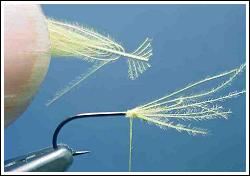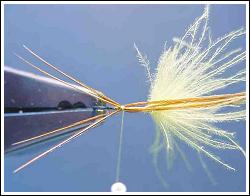|
The CDC Yellow Mayday
By Martin
Westbeek

CDC is a wonderful material for flytying, and I use it quite a bit in both dry flies, emergers and nymphs. One thing I was not satisfied with however, was the way a CDC front hackle looked like. The relatively thick stem often creates too much bulk and distorts the fine barbs, no matter what I tried. One day I saw a tyer use CDC for spider patterns and he used a technique that would solve the problem: the pull-and-clip technique. With this technique we can make a dense CDC hackle, without the bother and bulk of the stem. The fly below is the Yellow CDC Mayday. Of course the technique works equally well for BWOs, Sulphurs, and other patterns. The method may look a little time-consuming, but once you've got the hang of it you'll find that it is a quick technique that gives you a very nice result. Have fun!
Thread: Uni 8/0, yellow
Hook: TMC 102Y, #17
Wing: CDC
Body: Ultrafine, yellow
Tails: bleached PT
Step 1
Start by slipping 1/2" of silicone tube on the tube of your bobbin (holder) You'll need it in step 13. Spin the bobbin clockwise and create a thread bump right behind the eye of the hook.

2.
Select a CDC feather, stroke the barbs back, and cut out the tip. Hold the feather in your left hand, and pull out 4 to 5 fibers on each side.

3.
Tie in at your side of the hook. Just make one wrap, hard against the thread bump with the free fibers extending over the eye.

4.
Keeping the tread under tension, pull the CDC feather back slowly. The thread tension will keep the barbs in place, but the stem will be pulled out from under the wrap. You'll see - and hear - a soft snap when the stem is free.

5.
Cut the feather, and take care that you don't leave any stem.

6.
Rotate the vise, pull 4 to 5 fibers out at each side of the feather, and tie in with one wrap. Try to stay as close to the eye as possible.

7.
Pull the feather back out and clip off.

8.
Repeat until you've made one and a half turn with the hook, after which you'll have tied in and clipped the CDC feather 10 times or so - 4 above, 3 below and 4 above the hook shank. Always keep as close to the eye as possible, which is easy since there is no bulk at the tie-in point.

9.
Take the thread to the point above the hook point and make another thread bump.

10.
Tie in the tails; the thread bump will make them flare. Tie down tails, cut them and return to the bend.


11.
Dub the body, hard against the tie-in point.

12.
Push the fibers back and pull the thread through them from under the hook.

13.
Push the silicone tube over the CDC.

14.
Make a whip finish against the CDC fibers, so that they are firmly sandwiched between the thread and the body. Push the silicone tube back on the bobbin holder and then cut the thread.

15.
Using scissors, clip the CDC until you have the shape you want. Don't clip the fibers around the hackle, but make diagonal cuts in front of and behind the hackle, which produces a more irregular shape. Clip out a V at the underside of the hook.

Just add water. Good fishing!
By Martin Westbeek ©
Visit Martins website:
http://home.planet.nl/~westb001/ |